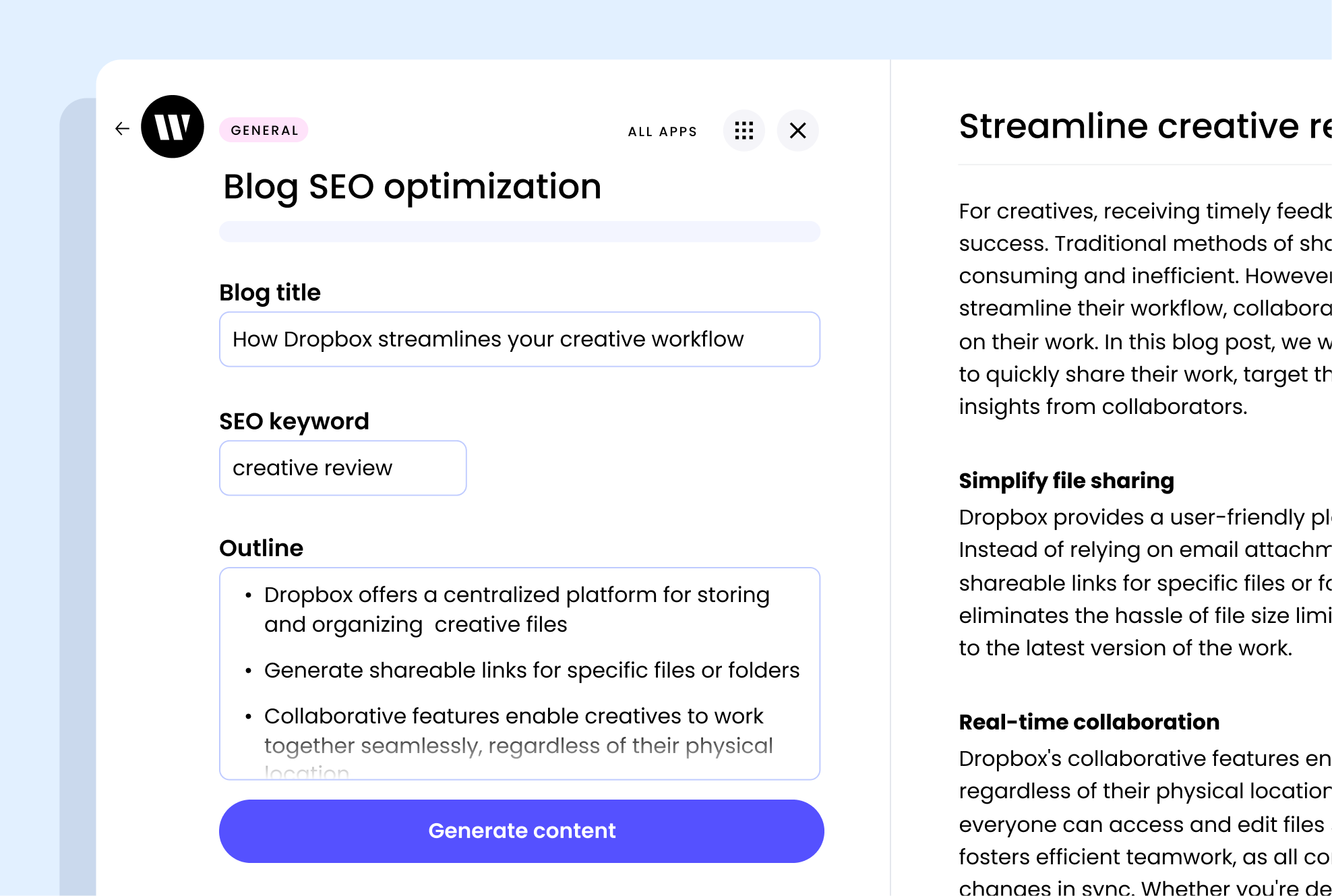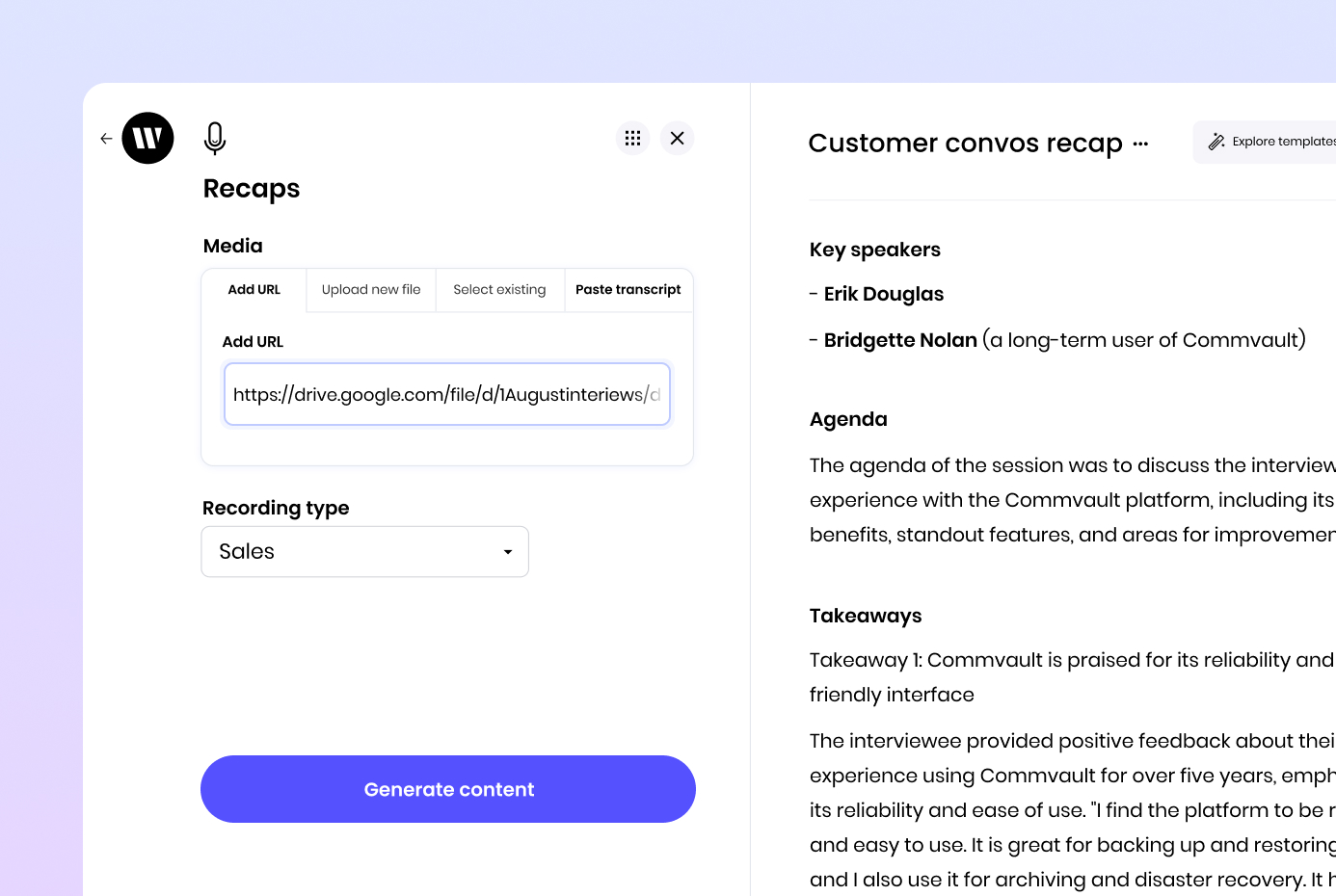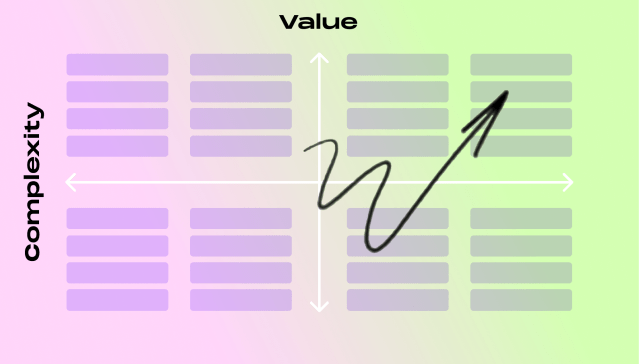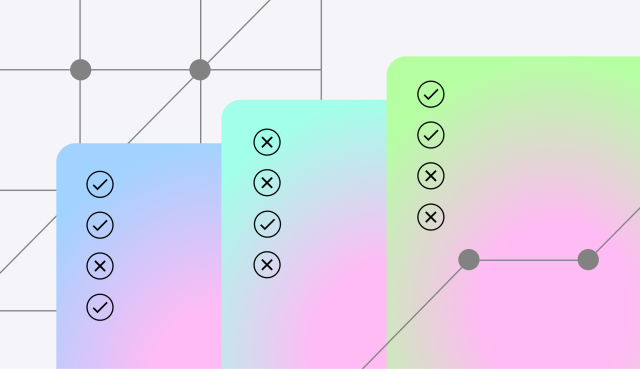AI in action
– 11 min read
From “…and?” to “ah-ha!”: How to discover powerful generative AI use cases for your marketing team

With any technology implementation, you’ll have the “go-getters” and “sit-backers.” Go-getters will see the value and try to uncover new ways of using a solution. Sit-backers will wait until a new use case is presented to them.
Disruptive technology will always exist. What’s unique about generative AI is the speed of disruption. Innovative solutions emerge → companies determine that it’ll solve a particular use case → the idea is put into production. All of this is happening at a rapid pace (at least among companies that know AI is the future).
Because of this cycle of idea-to-deployment, marketing teams have to plan for continuous use case adoption. This means strategizing: how can your team uncover new generative AI use cases and what steps are needed to implement them?
And as marketers, don’t we love a good strategy?
- Generative AI is disrupting industries at a rapid pace, and marketing teams need to plan for continuous use case adoption.
- A good generative AI use case depends on the marketing team’s operational maturity and requires standards for evaluating and editing output.
- Successful implementation of generative AI often starts with recognizing internal signals that AI could solve a problem or help the team.
- Without a framework for identifying and prioritizing use cases, marketing teams can’t operationalize and scale their use of generative AI.
What makes a good generative AI use case?
If you log into LinkedIn, or a community forum, or listen to a webinar or podcast, you’ll receive an endless supply of generative AI use cases. People on your team may have their own ideas. Some will be amazing … and some won’t be the right fit for your team.
A good fit depends on your marketing team’s operational maturity. If the team’s work and processes lack consistency, it can be hard to fit generative AI into your workflow. You also need standards for evaluating and editing generative AI output. This can only happen when the team has a standardized understanding of what the output should be.
If your team has only worked with simple generative AI use cases, introducing something complex isn’t a logical next step. You have to create a foundation first. If your team has a good handle on generative AI, then good use cases will continue to build and scale your operations.
At a minimum, you need an internal process to identify potential use cases, no matter their source. You can task people, such as team leads, to be on the lookout. The potential uses cases can move up the ladder to an AI program director to determine if they’re worth pursuing.
Remember that good use cases on Day 1 won’t be the same as Day 101. You can keep a list of potential use cases that aren’t a good fit now, but may be in the future.
A framework for prioritizing AI use cases
Once you’ve initially determined a “good use case” versus “not good use case,” you’ll need to rank its priority against other use cases you’d like to tackle.
This is called use case mapping. You’re aligning the specific use case with your overall business objectives and goals. Either way, you’re prioritizing the use case based on either the problem it solves or the opportunity it presents.
Determine the value
We’ll assume that the use case has value for your team, or it wouldn’t have fallen into the category of “good use case.” However, some use cases will have a higher value than others.
For example, a use case that impacts many people on the team will be of higher value than a use case that only applies to a few people.
You’ll also want to consider the potential time saved. If you’re considering a use case that impacts only a few people, but will save them a lot of time, that’s a high-value use case.
Let’s say you want to use generative AI to repurpose a webinar into a blog post. How many webinars does your company hold per month? If you hold a lot, this use case could save a ton of time. If you only hold one webinar every six months, this use case still might be useful, but not as much as something your marketing team does every day.
Determine the complexity
In some instances, your team will have everything they need at their fingertips to implement the use cases. You’ll need to consider the prompt used, and try a few different iterations to find the one that works best.
Others may be more complex. Maybe users need to gather inputs from several different sources to create a robust prompt. If your users have only worked with simple prompts before, they may need training or templates to help them craft a prompt that produces high-quality output.
In other cases, you’ll want to bolster generative AI with your own company data, such as internal guides, documents, and databases. While large language models (LLMs) are powerful on their own, they’re even more powerful with specific context from your business.
Retrieval-augmented generation (RAG) combines external data with your LLM. While there’s more involved in connecting various systems, your team will benefit from more accurate and contextualized output.
Learn more about our Knowledge Graph and WRITER’s approach to RAG.
Determine the solution
Your team can interact with generative AI in different ways, from an application to a Chrome extension. As you prioritize use cases, you’ll want to think about how they fit into your workflow — and what might change as a result of implementing the use case.
You may already have access to some (or all!) of the following generative AI solutions, or you may need to consider adding them to your tech stack.
- Chat interface: best for creative outputs, sparking ideas, or finding information with a conversational flow
- Prebuilt applications: best for out-of-the-box text generation that follows a standard workflow (such as creating an outline based on a keyword)
- Custom applications: best for following company-specific use cases, custom applications can be a combination of chat, text generation, or re-writing content based on specific guidelines
If you need a highly specific prompt to generate consistent output, you’ll need a prebuilt or custom application. Chat interfaces are so unstructured that it’s hard to get a good result without a really skilled user. Or, you’ll get a result, but the result needs a lot of editing. Prebuilt and custom applications user interfaces that maintain the same structure for the prompt, no matter which user is interacting with it.

Six marketing teams and their “ah-ha” AI use case moments
For marketing teams that successfully implement generative AI use cases, it often starts as an “aha moment.” There were internal signals that AI could either solve a problem or help the team in some way.
The key is recognizing those cues and then putting the chosen solution into action.
Driving brand consistency among various contributors
Content often has a “too many cooks” problem. As marketing teams grow larger, and go-to-market strategies evolve, it becomes harder to maintain consistent brand terminology and company voice. Teams may rely on a written style and messaging guides, but it can be hard to review and even harder to enforce.
This was the case at Dropbox. “The guidelines were just this passive document in Dropbox that people would have to remember existed and then go check, and people just weren’t doing it,” says Angelique Little, Content Design Lead at Dropbox. Consistency became an even bigger issue as Dropbox looked to expand its thought leadership content across more contributors within the company.
Bamboo Rose also has content from varying contributors, but for a different reason. The company has made acquisitions part of its growth strategy. When the acquisition is complete, the Bamboo Rose content team has inherited content assets that need to be edited for the company’s guidelines.
In both cases, the companies selected WRITER to solve their content editing challenges. With in-application enforcement and suggestions, marketing teams can ensure consistent terminology, phrasing, and inclusive language.
“WRITER can accelerate our ability to create that synergy and speed up time to market to unify perception of the company,” says Jennifer Schiffman, CMO of Bamboo Rose. “We don’t feel disparate.”
Discover how WRITER ensures all your work is compliant, accurate, inclusive, and on-brand wherever your people work. Take a self-guided tour of our AI guardrails
Enabling leadership and GTM teams with key insights
Commvault does a lot of customer and prospect interviews, generating hours of call recordings every week. The marketing team would then wait for a researcher to write an executive summary.
“Think about how hard it is to truly synthesize a ton of data from two-hour interviews down to a nugget of a paragraph summary,” says Anna Griffin, CMO at Commvault. It was a time-consuming process and could often hold up internal meetings to discuss the findings.
With WRITER, the Commvault team can get a summary in seconds using the recaps feature.

“My team and I are freed up from [this work],” Griffin says. “We’re getting insights faster and we’re executing on them and putting them into market faster.”
This go-to-market motion, powered by generative AI, also enabled the sales team at Carta. A demand generation marketer saw the potential in using WRITER to quickly summarize a virtual event for the sales team. That way, the sales team could reference the key takeaways from the event when talking with prospects.
“I expected WRITER to help us on pure content,” says Carta Chief Marketing Office Jane Alexander. “What I wasn’t expecting is that it would create more efficiency in how our team members talk to cross-functional team members, and draw insights.”
Explore our AI apps for analyzing and surfacing insights. Take a self-guided tour of a custom summary app.
Freeing up creative minds from drudge work and blank-page paralysis
Anyone who’s written a press release knows that they’re the definition of highly structured content. They’re written for web crawlers, not human readers. The marketing team at Adore Me (acquired by Victoria’s Secret) found writing press releases to be painful, albeit necessary.
Ranjan Roy, SVP of Strategy, describes the “light bulb moment” in realizing that press releases were a perfect use case for generative AI. It showed him, “This could make our life easier, because everyone hates writing press releases.”
Users can feed 8–10 relevant bullet points for the topic by using an application within WRITER. A full press release is then generated. Roy remembers initially reviewing the output and thinking it could be uploaded directly to PR Newswire.
“WRITER is well-tailored to actually solving real business problems for us,” says Roy.
For other marketers, generative AI can be a launching pad. Mary Ellen Slayter, CEO at Rep Cap, describes herself as an editor more than a writer. “If you give me stuff, I’m good at shaping it into things,” she says. Rep Cap uses WRITER to generate ideas from interviews, large research reports, and other content assets.
“I look at generative AI as a way to take the knowledge and the experience that I have, and the team has, and do better work and scale with it,” she says. “My content team jokingly calls WRITER the fifth member of our team.”
Get a peek at some of the many ways WRITER can free up your marketing team. Check out our self-guided product tours.
Follow the path of organizational goals
Many marketing teams have accepted that generative AI will be part of their lives, but far fewer have implemented a strategy. Right now, they may rely on individual users tinkering with free tools or have haphazardly implemented a paid solution.
While individual curiosity can certainly drive excitement, it doesn’t necessarily serve an overall business goal. Instead, teams should systematically uncover individual ideas, determine if they’re a good use case, and take the steps to implement them.
Without a framework for identifying and prioritizing use cases, marketing teams can’t operationalize and scale their use of generative AI. The real power moves beyond individual productivity and can drive measurable results.
Read more: A six-step path to ROI for generative AI






